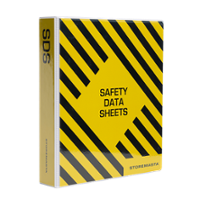If your workplace uses or handles hazardous chemicals, you are legally required by Australian WHS Regulations to keep a register of hazardous chemicals on the job site. This post will help you learn how to prepare and install a register of hazardous chemicals that complies with the law.
IMPORTANT: A hazardous chemical register is an essential requirement under WHS law. If your business doesn’t have the correct documents in place, you could face penalties of up to $30,000.
What is a Register of Hazardous Chemicals?
A register of hazardous chemicals is a list of all hazardous chemicals kept at the workplace, as well as the current Safety Data Sheet (SDS) for each chemical product.
Under the Work Health and Safety Regulations, the register must be prepared and maintained, so that people can easily find the current information about all hazardous chemicals that are stored, handled or used in your workplace.

Your chemical register must be implemented and maintained so that all personnel understand which chemicals are onsite.
Your register must be easily accessible to any workers or contractors who are likely to be exposed to the chemical hazards. The register should also be accessible to emergency responders.
IMPORTANT: We recommend workplaces keep their essential chemical documents in a clearly marked document holder. This can be installed in a highly visible location, such as near the entry to the work area.
Obtaining Safety Data Sheets (SDS)
SDS are an essential part of your hazardous chemical register because they contain vital information about:
- The chemical properties of hazardous substance
- The hazard class assigned by the GHS
- Health hazards, acute adverse health conditions, and chronic illnesses caused by the chemicals
- Safe handling and storage instructions
- Recommended personal protective equipment (PPE)
- First aid and emergency responses
- The impact on physical property and the environment
The first job in obtaining these Safety Data Sheets and creating your hazardous chemical register is to conduct a walk-around of the worksite and physically locate all the chemicals.
 The availability and relevancy of your SDS can help reduce the impact and likelihood of a chemical hazard occurring in your workplace.
The availability and relevancy of your SDS can help reduce the impact and likelihood of a chemical hazard occurring in your workplace.
You might have already done this during your risk identification and assessment processes, but if you haven’t consider printing out a site map and walking around with the staff or contractors assigned to each work area.
Next you will create a master list of the chemical names and begin collating the SDS you have for each of the chemicals. You can also include additional information in your register, such as the onsite location where the chemical is used/stored; name of the manufacturer/supplier, and the issue date of the SDS.
Maintaining Up-To-Date SDSs
Chemical manufacturers and importers are required to update the SDS for their chemicals at least once every five years. They must also update the SDS if changes in the manufacturing processes (or in scientific research) alter the risks and hazards of the chemical.
You are required by law to have the current SDS for every chemical, so if any of them are more than 5 years old, you should immediately know there is a problem.
SDSs should only be obtained from the actual supplier, importer or manufacturer of the chemicals because the chemical properties of a substance can vary (even between batches). This variance may be enough to increase or reduce the physical hazards and health hazards of a substance.
Implementing Your Chemical Register
Once you have created your register, you need to find a safe, accessible space to keep the register.

Your register of hazardous chemicals should be available in both hard copy and electronic copy.
The register should be easily accessible in all relevant work areas of your business.
IMPORTANT: We recommend having your master register stored electronically on the company intranet, as well as implementing hard copies in locations where the chemicals are being used.
Using An Electronic Register
If you decide to use an electronic register of hazardous chemicals, please ensure that:
- Staff can physically access the computer terminals, they know the required passwords, and have sufficient IT knowledge to use the system correctly.
- Computers or individual workstations are operational and kept updated so they don’t lock up or freeze when staff need to quickly locate an SDS or chemical hazard information
- An exact copy of the original Safety Data Sheets (eg, PDF) is used and available in a resolution that is perfectly visible.
- Mechanisms are in place to ensure the register is still accessible during maintenance shutdowns, blackouts, and power outages.
- The register is regularly updated as new chemicals are introduced or obsolete chemicals removed from the workplace.
Using A Hard-Copy Register
When using a hard copy paper register, we suggest you:
- Keep your register in a dedicated document box or HAZMAT box that protects paper SDSs and the Master List of chemicals from dust, vermin, and the weather.
- Have you register on hand in work areas where chemicals are used and stored by fixing your document box/tube to the exterior of forklifts; HAZCHEM stores; and other operating plant.
- Don’t store documents printed with inkjet printers or on thermal paper that might cause the printed information to fade or disappear.
- Make sure the printed documents are perfectly clear and easy to read — not faint, light or with lines through the text.
- Check the documents periodically and replace with new printouts if they become faded or damaged.
- Make sure your staff and contractors know where to find the register and are trained to put SDS back in their containers or document box after being used.
- Conduct regular audits to make sure SDSs haven’t been misplaced or removed from the register and any new/unused chemicals are added (or removed).
IMPORTANT: Don’t confuse a Register of Hazardous Chemicals with a Manifest of Hazardous Chemicals, as these are two different documents which have two distinct purposes. There are also different legal requirements for the preparation and implementation of the Manifest of Hazardous Chemicals.
Mistakes To Avoid When Creating A Hazardous Chemical Register
There are some common mistakes that we see businesses make when they’re implementing a register in their own workplace. Read this list to find out what you should avoid doing, and make sure that your register is not following these examples.
10 Common MISTAKES That Are Made When Implementing A Hazardous Chemical Register
- Having Safety Data Sheets in the register that are more than 5 years old
- Keeping the register locked in a manager’s office
- Not removing the details of a substance that is no longer used on the worksite
- Storing the register on a password protected PC that is only accessible when the WHS Safety Manager is on shift
- Downloading generic Safety Data Sheets (SDSs) from the internet rather than getting the official SDS issued by the manufacturer or supplier
- Listing consumer products that aren’t required to be on the register (eg, a staff member’s personal deodorant)
- Not updating the register when a new chemical is introduced to the workplace
- Putting hard copy SDSs in thin plastic sleeves that quickly deteriorate outdoors or in a heavy industrial environment
- Not having the register where the chemicals are being used (eg, forklift drivers who load and unload chemicals need to quickly access the register)
- Not training your staff about chemical hazards and how to read and use a Safety Data Sheet
IMPORTANT: The WHS Regulations require that ‘sufficient information about the safe use, handling and storage of the hazardous chemical is readily accessible to any worker at the workplace; any emergency service worker, or anyone else who is likely to be exposed to hazardous chemicals at the workplace.’
Keeping A Hazardous Chemical Register In Your Workplace
Would you like to learn more about controlling the chemical hazards at your workplace? Then why not download our free eBook? How To Manage The Risk Of Hazardous Chemicals In The Workplace is written in clear, easy-to-understand language that will help you implement a chemical risk management methodology. You’ll also gain valuable knowledge about safety inspections and audits, which are an essential part of your overall chemical safety strategy. Access your copy of our eBook today and learn more about managing chemical risk.
Joining the team as a Dangerous Goods Storage Consultant, Melissa Hampton became Storemasta's Marketing Manager in late 2021. With extensive knowledge and experience in chemical compliance, Melissa is responsible for leading the Marketing team and helping shape their marketing strategy. In her spare time, you can find Melissa hiking, swimming and enjoying the great outdoors in beautiful north-west Tasmania.
